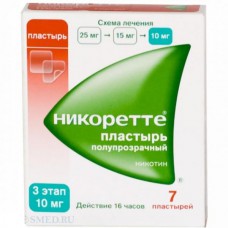Expiration date: 02/2026
The composition and form of issue:
Transdermal therapeutic system (patch) 1 cm2
nicotine 0,83 mg
excipients: film substrate polyester non-woven, the medium molecular polyisobutylene, low molecular weight polyisobutylene, polybutene, polyester siliconized
in sachet 1 patch 5 mg/16 hours 10 mg/16 h or 15 mg/16 h in the stack cartons 7 or 14 sachets.
Description pharmaceutical form:
Patch 5 mg/16 h patch is rectangular in shape with rounded edges with an area of 10 cm2, one side is light brown with the inscription "nicorette", and the second adhesive, silver-white, covered with transparent synthetic protective film.
The patch 10 mg/16 h patch is rectangular in shape with rounded edges with an area of 20 cm2 one side is light brown with the inscription "nicorette", and the second adhesive, silver-white, covered with transparent synthetic protective film.
The patch 15 mg/16 h patch is rectangular in shape with rounded edges with a size of 30 cm2, one side is light brown with the inscription "nicorette", and the second adhesive, silver-white, covered with transparent synthetic protective film.
Pharmacokinetics:
The pharmacokinetics of nicotine is comparable when applying the patch to the skin of the arm or thigh.
Suction. After applying the patch to the skin of the arm or thigh approximately 95% of the released nicotine enters the systemic circulation. The remainder evaporates on the edges of the patch. All patches shows the average amount of nicotine that is absorbed the average patient for 16 hours
Cmax of nicotine in plasma after applying the patch is achieved after 6-10 h after application of patch 15 mg/16 h is 9-15 ng/ml. If the patch 15 mg/16 h, left for 24 hours (not 16 hours), the concentration of nicotine within the last 8 hours the average is reduced from 7.2 to 5.6 ng/ml When using patches of smaller size we can expect similar changes in the concentration of nicotine in plasma.
When using three dosages of the patch concentration of nicotine in plasma did not increase proportionally to the dose increase: if you increase the size of the patch corresponding increase in concentration was somewhat lower than expected.
Distribution. The binding of nicotine with blood plasma proteins is less than 5%. In this regard, violations of binding nicotine with simultaneous use of other drugs or changing the amount of protein in the plasma in various diseases should not have a significant effect on the kinetics of nicotine.
Repeated use of the adhesive the concentration of nicotine is not significantly higher than that after a single use.
Metabolism. Nicotine is metabolized in the liver, kidney and lung. Identified more 20 metabolites, which are inferior in activity of the nicotine. The concentration of primary metabolite — cotinine — exceeds the concentration of nicotine in 10 times.
Excretion. Excreted mainly by the liver. The average plasma clearance is about 70 l/h. T1/2 about 2 h.
With urine are deduced basically cotinine (15% of the dose, T1/2 — 15-20 h) and TRANS-3-hydroxy-cotinine (45% of the dose). 10-30% of a dose of nicotine excreted in the urine unchanged.
Pharmacokinetics in special clinical cases
Progressive deterioration of renal function is accompanied by decreased total clearance of nicotine.
The pharmacokinetics of nicotine is not significantly altered in patients with liver cirrhosis with marginally severe disorders of liver function (5 points on a scale child-Pugh) and reduced in patients with liver cirrhosis with moderate-to-severe disorders of liver function (7 points on a scale child-Pugh).
In patients, on hemodialysis, noted the increase in the concentration of nicotine in plasma.
In elderly patients there is a decrease in total clearance of nicotine, that does not require dose adjustment.
Description pharmacological action:
After a sharp quitting patients for long time daily using nikotinsoderzhaschie products, it is possible to develop withdrawal that includes dysphoria, insomnia, increased irritability, anxiety, impaired concentration, reduced heart rate, increased appetite and weight gain, as well as the desire to smoke.
In the treatment nicotine replacement therapy nicotine may reduce the need to smoke and number of cigarettes smoked, to reduce the severity of withdrawal symptoms that occur when the full stop Smoking those, who have decided to quit Smoking. Facilitates temporary abstinence from Smoking and helps to reduce the number of cigarettes in those who is unable or unwilling to completely quit Smoking.
Indications:
treatment of tobacco dependence by reducing the need to smoke
the removal of withdrawal symptoms that occur when quitting Smoking in patients who have appropriate motivation.
Contraindications:
Hypersensitivity to the drug.
With caution:
patients who had cardiovascular disease or gospitalizirovany for this reason during the previous 4 weeks (e.g. stroke, myocardial infarction, unstable angina, arrhythmia, coronary artery bypass grafting, angioplasty), or with uncontrolled arterial hypertension (consult a physician)
patients with moderate or severe liver dysfunction, severe renal impairment, aggravation of gastric ulcer and duodenal ulcer
patients with uncontrolled hyperthyroidism, pheochromocytoma (due to the fact that nicotine causes release of catecholamines from the cerebral napochechnikov layer).
Application of pregnancy and breast-feeding:
The question about the possibility of using the drug during pregnancy is solved individually.
Nicotine penetrates through the placental barrier and affects the respiratory system and blood circulation of a fetus (depending on dose). Risk to the fetus associated with the use of the drug during pregnancy are not fully understood. Use replacement therapy nicotine for pregnant women who cannot quit Smoking far outweighs the risk associated with continued Smoking.
Nicotine (even when used in therapeutic doses) in small amounts excreted in breast milk and may affect a newborn. If necessary, use of the drug during lactation should stop breastfeeding.
Side effects:
Patches Nicorette can cause unwanted dose-dependent (primarily) effects, similar to that resulting from the use of nicotine entering the body by other means.
When describing the side effects, the following criteria of frequency of occurrence: very often (>1/10), often (>1/100 <1/10), infrequently (>1/1000, <1/100), rare (>1/10000, <1/1000), very rare (<1/10000), including isolated cases.
Dizziness, headache, sleep disorders can be manifestations of the withdrawal syndrome caused by quitting Smoking. When quitting Smoking may increase the incidence of canker sores (reason unknown).
Local reactions: about 20% — moderately expressed, redness, itching.
From the side of cardiovascular system: rarely — palpitations very rare — atrial fibrillation.
From the digestive system: often — nausea, vomiting.
Dermatological reactions: rare — urticaria.
From the body as a whole: often — itching is often erythema.
Drug interactions:
Smoking (but not the use nicotine) causes an increase in activity of isoenzyme CYP1A2. After Smoking cessation may be reduced clearance of substrates of this enzyme, which may lead to increased concentrations of certain drugs in the blood plasma that has potential clinical value of simultaneous use of drugs, characterized by a low breadth of therapeutic action (theophylline, tacrine, clozapine, ropinirole).
After Smoking cessation in the plasma may increase the concentration of other drugs that are metabolized partially by the action of isoenzyme CYP1A2 (such as imipramine, olanzapine, clomipramine, fluvoxamine), although data confirming this are lacking and the possible clinical significance of this interaction is not known.
Limited data indicate that Smoking may induce the metabolism flecainide and pentazocine.
Method of application and dose:
Externally. Adults (including the elderly) treatment starts with the application of a patch 15 mg/16 h (30 cm2) that is applied to intact skin daily in the morning (immediately after awakening) and are removed before sleep.
The duration of the initial period of therapy is determined individually, usually it is at least 3 months. Then substitutive therapy is gradually discontinued. When you do this for 2-3 weeks daily impose one patch 10 mg/16 h (20 cm2), and within the next 2-3 weeks — one patch 5 mg/16 h (10 cm2).
Apply patches for more than 6 months is generally not recommended.
In some cases, persons who quit Smoking may require longer therapy.
Overdose:
Excessive intake of nicotine replacement therapy and/or Smoking might cause symptoms of overdose.
Symptoms: nausea, salivation, abdominal pain, diarrhoea, sweating, headache, dizziness, hearing disorders, severe weakness (like the manifestations of acute poisoning by nicotine). With the use of high doses of nicotine possible decrease in blood pressure, weak and intermittent pulse, difficulty breathing, circulatory collapse, generalized convulsions, prostration.
Portable nicotine in adult smokers doses can cause severe intoxication in young children (including fatalities).
Treatment: should immediately stop using the product (remove the patch) and start symptomatic therapy.
Special instructions:
Patients with diabetes after Smoking cessation may require lower doses of insulin.
Use in Pediatrics
The question of prescribing the drug to patients under the age of 18 years is solved by the doctor individually. Experience in application of plaster in this age group is limited.




